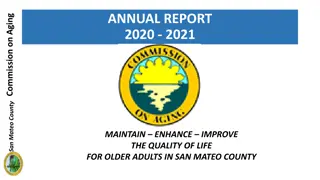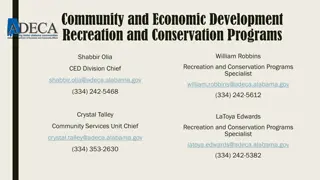
Basics of Biochemistry and Cellular Processes
Explore the fascinating world of biochemistry, which delves into the chemical processes at the molecular level in living organisms. Learn about the structure of complex molecules, cellular organization, metabolism, and the key principles governing life. Discover the difference between prokaryotic and eukaryotic cells and how they function at their fundamental level.
Download Presentation

Please find below an Image/Link to download the presentation.
The content on the website is provided AS IS for your information and personal use only. It may not be sold, licensed, or shared on other websites without obtaining consent from the author. If you encounter any issues during the download, it is possible that the publisher has removed the file from their server.
You are allowed to download the files provided on this website for personal or commercial use, subject to the condition that they are used lawfully. All files are the property of their respective owners.
The content on the website is provided AS IS for your information and personal use only. It may not be sold, licensed, or shared on other websites without obtaining consent from the author.
E N D
Presentation Transcript
WHAT IS BIOCHEMISTRY Biochemistry is the application of chemistry to the study of biological processes at the cellular and molecular level. It emerged as a distinct discipline around the beginning of the scientists combined and biology to investigate the chemistry of living systems by: 20th chemistry, century when physiology
A. Studying the structure and behavior of the complex molecules found in biological material and the ways these molecules interact to form cells, tissues and whole organism Biochemistry has become the foundation for understanding all biological processes. It has provided explanations for the causes of many diseases in humans, animals and plants." B. C.
BIOCHEMISTRY CAN BE SUBDIVIDED THREE PRINCIPAL AREAS Structural chemistry Structural chemistry Metabolism Metabolism The chemistry of processes and substances The chemistry of processes and substances that store and transmit biological that store and transmit biological information information ( (molecular genetics molecular genetics) )
PRINCIPLES OF BIOCHEMISTRY The cell is the fundamental unit of life The cell is the fundamental unit of life Cells (basic structural units of living organisms) are highly organized and constant source of energy is required to maintain the ordered state. The cell is the basic unit of all living things, and all organisms are composed of one or more The cell is the basic unit of all living things, and all organisms are composed of one or more cells. cells. Living processes contains thousands of chemical reactions. Precise regulation and integration of these reactions are required to maintain life Certain important reactions E.g. Glycolysis is found in almost all organisms. All organisms use the same type of molecules: CHO, proteins, lipids & nucleic acids. Instructions for growth, reproduction and developments for each organism is encoded in their DNA
CELLS MAY BE PROKARYOTIC OR EUKARYOTIC Prokaryotes include bacteria & lack a nucleus or membrane- bound structures called organelles Eukaryotes include most other cells & have a nucleus and membrane-bound organelles (plants, fungi, & animals)
Contain 3 basic cell structures: Nucleus Cell Membrane Cytoplasm with organelles Nucleoid region contains the DNA Cell membrane & cell wall Contain ribosomes (no membrane) to make proteins in their cytoplasm
Prokaryotic Cell Prokaryotic Cell The organisms made of prokaryotic cells are called prokaryotes e.g. bacteria and cyanobacteria. The organisms made of prokaryotic cells are called prokaryotes e.g. bacteria and cyanobacteria. These cells lack a membrane bound nucleus. These cells lack a membrane bound nucleus. The hereditary material (DNA) is found in cytoplasm. The hereditary material (DNA) is found in cytoplasm. These cells lack membrane bound organelles. These cells lack membrane bound organelles. Ribosome Ribosome s are of small size in and freely scattered cytoplasm. s are of small size in and freely scattered cytoplasm. Cellulose is absent in cell wall, rather it is made up of Cellulose is absent in cell wall, rather it is made up of peptido peptido- -glycan or murrain. glycan or murrain. These cells are simple and of smaller size (average diameter These cells are simple and of smaller size (average diameter 0.5 0.5 10 10 nm) nm) Eukaryotic Cell Eukaryotic Cell The organisms made of Eukaryotic cells are called Eukaryotes, e.g. animals, plants fungi and The organisms made of Eukaryotic cells are called Eukaryotes, e.g. animals, plants fungi and protista protista. . These cells have a membrane bound nucleus; and hereditary material is found inside the nucleus. These cells have a membrane bound nucleus; and hereditary material is found inside the nucleus. These cells have membrane bound organelles. These cells have membrane bound organelles. Ribosome Ribosome s are of large size and are present in endoplasmic reticulum free in cytoplasm. s are of large size and are present in endoplasmic reticulum free in cytoplasm. Cellulose is present in cell wall of plant cells. The cell wall of most of fungi is composed of chitin. Cellulose is present in cell wall of plant cells. The cell wall of most of fungi is composed of chitin. nm). ). These cells are complex and of larger size (Average diameter These cells are complex and of larger size (Average diameter 10 10- -100 100nm
Eukaryotic Eukaryotic cell animal cells plant cells (chloroplasts and cell walls) cell
Characteristic Bio-membranes and Organelles Cell membrane A lipid/protein/carbohydrate complex, providing a barrier and containing transport and signaling systems. Nucleus Double membrane surrounding the chromosomes and the nucleolus. Pores allow specific communication with the cytoplasm. The nucleolus is a site for synthesis of RNA making up the ribosome Mitochondrion Surrounded by a double membrane with a series of folds called cristae. Functions in energy production through metabolism. Contains its own DNA, and is believed to have originated as a captured bacterium. Chloroplasts (plastids) Surrounded by a double membrane, containing stacked thylakoid membranes. Responsible for photosynthesis, the trapping of light energy for the synthesis of sugars. Contains DNA, and like mitochondria is believed to have originated as a captured bacterium.
Rough endoplasmic reticulum (RER) A network of interconnected membranes forming channels within the cell. Covered with ribosomes (causing the "rough" appearance) which are in the process of synthesizing proteins for secretion or localization in membranes. Ribosomes Protein and RNA complex responsible for protein synthesis Smooth endoplasmic reticulum (SER) A network of interconnected membranes forming channels within the cell. A site for synthesis and metabolism of lipids. Also contains enzymes for detoxifying chemicals including drugs and pesticides. . Golgi apparatus A series of stacked membranes. Vesicles (small membrane surrounded bags) carry materials from the RER to the Golgi apparatus. Vesicles move between the stacks while the proteins are "processed" to a mature form. Vesicles then carry newly formed membrane and secreted proteins to their final destinations including secretion or membrane localization. Lysosymes A membrane bound organelle that is responsible for degrading proteins and membranes in the cell, and also helps degrade materials ingested by the cell.
Vacuoles Membrane surrounded "bags" that contain water and storage materials in plants. Peroxisomes or Microbodies Produce and degrade hydrogen peroxide, a toxic compound that can be produced during metabolism. Cell wall Plants have a rigid cell wall in addition to their cell membranes Cytoplasm enclosed by the plasma membrane, liquid portion called cytosol and it houses the membranous organelles. Cytoskeleton Arrays of protein filaments in the cytosol. Gives the cell its shape and provides basis for movement. E.g. microtubules and microfilaments.
BIOMOLECULES Cells are composed of: Cells are composed of: Small molecules Macromolecules organelles
The Approximate Chemical Composition of Bacterial Cell Percent of Total Cell Weight 70 1 Number of Types of Each Molecules 1 20 Water Inorganic ions Sugars and precursors 3 200 Amino acids and precursors Nucleotides and precursors Lipids and precursors 0.4 100 0.4 200 2 50 Other small molecules 0.2 ~200 Macromolecules 22 ~5000
Expect for water, most of the molecules found in Expect for water, most of the molecules found in the cell are the cell are macromolecules macromolecules, can be classified into into four four different categories: different categories: Lipids Carbohydrates Proteins Nucleic acids , can be classified




















